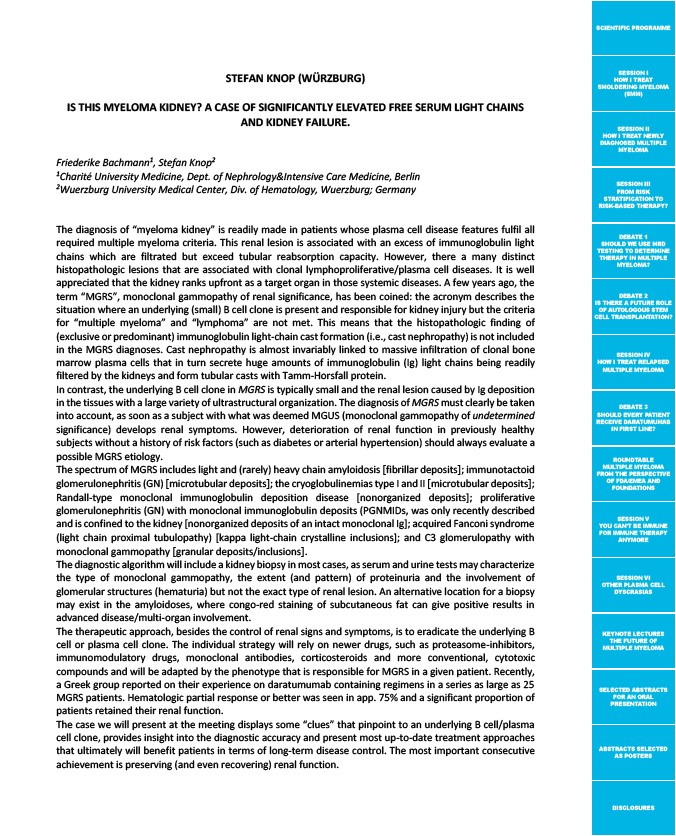
SCIENTIFIC PROGRAMME
SESSION I
HOW I TREAT
SMOLDERING MYELOMA
(SMM)
SESSION II
HOW I TREAT NEWLY
DIAGNOSED MULTIPLE
MYELOMA
SESSION III
FROM RISK
STRATIFICATION TO
RISK-BASED THERAPY?
DEBATE 1
SHOULD WE USE MRD
TESTING TO DETERMINE
THERAPY IN MULTIPLE
MYELOMA?
DEBATE 2
IS THERE A FUTURE ROLE
OF AUTOLOGOUS STEM
CELL TRANSPLANTATION?
SESSION IV
HOW I TREAT RELAPSED
MULTIPLE MYELOMA
DEBATE 3
SHOULD EVERY PATIENT
RECEIVE DARATUMUMAB
IN FIRST LINE?
ROUNDTABLE
MULTIPLE MYELOMA
FROM THE PERSPECTIVE
OF FDA/EMEA AND
FOUNDATIONS
SESSION V
YOU CAN’T BE IMMUNE
FOR IMMUNE THERAPY
ANYMORE
SESSION VI
OTHER PLASMA CELL
DYSCRASIAS
KEYNOTE LECTURES
THE FUTURE OF
MULTIPLE MYELOMA
SELECTED ABSTRACTS
FOR AN ORAL
PRESENTATION
ABSTRACTS SELECTED
AS POSTERS
DISCLOSURES
STEFAN KNOP (WÜRZBURG)
IS THIS MYELOMA KIDNEY? A CASE OF SIGNIFICANTLY ELEVATED FREE SERUM LIGHT CHAINS
AND KIDNEY FAILURE.
Friederike Bachmann1, Stefan Knop2
1Charité University Medicine, Dept. of Nephrology&Intensive Care Medicine, Berlin
2Wuerzburg University Medical Center, Div. of Hematology, Wuerzburg; Germany
The diagnosis of “myeloma kidney” is readily made in patients whose plasma cell disease features fulfil all
required multiple myeloma criteria. This renal lesion is associated with an excess of immunoglobulin light
chains which are filtrated but exceed tubular reabsorption capacity. However, there a many distinct
histopathologic lesions that are associated with clonal lymphoproliferative/plasma cell diseases. It is well
appreciated that the kidney ranks upfront as a target organ in those systemic diseases. A few years ago, the
term “MGRS”, monoclonal gammopathy of renal significance, has been coined: the acronym describes the
situation where an underlying (small) B cell clone is present and responsible for kidney injury but the criteria
for “multiple myeloma” and “lymphoma” are not met. This means that the histopathologic finding of
(exclusive or predominant) immunoglobulin light-chain cast formation (i.e., cast nephropathy) is not included
in the MGRS diagnoses. Cast nephropathy is almost invariably linked to massive infiltration of clonal bone
marrow plasma cells that in turn secrete huge amounts of immunoglobulin (Ig) light chains being readily
filtered by the kidneys and form tubular casts with Tamm-Horsfall protein.
In contrast, the underlying B cell clone in MGRS is typically small and the renal lesion caused by Ig deposition
in the tissues with a large variety of ultrastructural organization. The diagnosis of MGRS must clearly be taken
into account, as soon as a subject with what was deemed MGUS (monoclonal gammopathy of undetermined
significance) develops renal symptoms. However, deterioration of renal function in previously healthy
subjects without a history of risk factors (such as diabetes or arterial hypertension) should always evaluate a
possible MGRS etiology.
The spectrum of MGRS includes light and (rarely) heavy chain amyloidosis fibrillar deposits; immunotactoid
glomerulonephritis (GN) microtubular deposits; the cryoglobulinemias type I and II microtubular deposits;
Randall-type monoclonal immunoglobulin deposition disease nonorganized deposits; proliferative
glomerulonephritis (GN) with monoclonal immunoglobulin deposits (PGNMIDs, was only recently described
and is confined to the kidney nonorganized deposits of an intact monoclonal Ig; acquired Fanconi syndrome
(light chain proximal tubulopathy) kappa light-chain crystalline inclusions; and C3 glomerulopathy with
monoclonal gammopathy granular deposits/inclusions.
The diagnostic algorithm will include a kidney biopsy in most cases, as serum and urine tests may characterize
the type of monoclonal gammopathy, the extent (and pattern) of proteinuria and the involvement of
glomerular structures (hematuria) but not the exact type of renal lesion. An alternative location for a biopsy
may exist in the amyloidoses, where congo-red staining of subcutaneous fat can give positive results in
advanced disease/multi-organ involvement.
The therapeutic approach, besides the control of renal signs and symptoms, is to eradicate the underlying B
cell or plasma cell clone. The individual strategy will rely on newer drugs, such as proteasome-inhibitors,
immunomodulatory drugs, monoclonal antibodies, corticosteroids and more conventional, cytotoxic
compounds and will be adapted by the phenotype that is responsible for MGRS in a given patient. Recently,
a Greek group reported on their experience on daratumumab containing regimens in a series as large as 25
MGRS patients. Hematologic partial response or better was seen in app. 75% and a significant proportion of
patients retained their renal function.
The case we will present at the meeting displays some “clues” that pinpoint to an underlying B cell/plasma
cell clone, provides insight into the diagnostic accuracy and present most up-to-date treatment approaches
that ultimately will benefit patients in terms of long-term disease control. The most important consecutive
achievement is preserving (and even recovering) renal function.